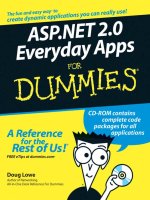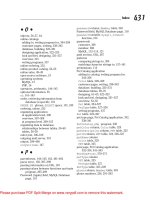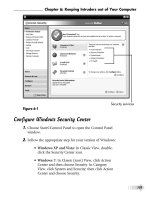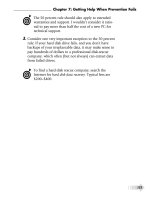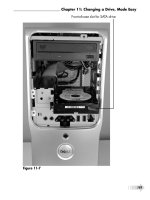Calculus 1,001 practice problems for dummies
Bạn đang xem bản rút gọn của tài liệu. Xem và tải ngay bản đầy đủ của tài liệu tại đây (11.09 MB, 626 trang )
www.it-ebooks.info
www.it-ebooks.info
s
u
l
u
c
l
a
C
1
0
0
,
1
s
m
e
l
b
o
r
P
e
c
i
t
Prac
www.it-ebooks.info
www.it-ebooks.info
s
u
l
u
c
l
a
C
1
0
0
,
1
s
m
e
l
b
o
r
P
e
c
i
t
Prac
by PatrickJMT
www.it-ebooks.info
1,001 Calculus Practice Problems For Dummies®
,
Published by: John Wiley & Sons, Inc., 111 River St., Hoboken, NJ 07030-5774, www.wiley.com
Copyright © 2014 by John Wiley & Sons, Inc., Hoboken, New Jersey
Media and software compilation copyright © 2014 by John Wiley & Sons, Inc. All rights reserved.
Published simultaneously in Canada
No part of this publication may be reproduced, stored in a retrieval system or transmitted in any
form or by any means, electronic, mechanical, photocopying, recording, scanning or otherwise, except
as permitted under Sections 107 or 108 of the 1976 United States Copyright Act, without the prior
written permission of the Publisher. Requests to the Publisher for permission should be addressed
to the Permissions Department, John Wiley & Sons, Inc., 111 River Street, Hoboken, NJ 07030, (201)
748-6011, fax (201) 748-6008, or online at />Trademarks: Wiley, For Dummies, the Dummies Man logo, Dummies.com, Making Everything Easier, and
related trade dress are trademarks or registered trademarks of John Wiley & Sons, Inc., and may not be
used without written permission. All other trademarks are the property of their respective owners. John
Wiley & Sons, Inc., is not associated with any product or vendor mentioned in this book.
LIMIT OF LIABILITY/DISCLAIMER OF WARRANTY: WHILE THE PUBLISHER AND AUTHOR HAVE
USED THEIR BEST EFFORTS IN PREPARING THIS BOOK, THEY MAKE NO REPRESENTATIONS OR
WARRANTIES WITH RESPECT TO THE ACCURACY OR COMPLETENESS OF THE CONTENTS OF
THIS BOOK AND SPECIFICALLY DISCLAIM ANY IMPLIED WARRANTIES OF MERCHANTABILITY
OR FITNESS FOR A PARTICULAR PURPOSE. NO WARRANTY MAY BE CREATED OR EXTENDED
BY SALES REPRESENTATIVES OR WRITTEN SALES MATERIALS. THE ADVICE AND STRATEGIES
CONTAINED HEREIN MAY NOT BE SUITABLE FOR YOUR SITUATION. YOU SHOULD CONSULT WITH
A PROFESSIONAL WHERE APPROPRIATE. NEITHER THE PUBLISHER NOR THE AUTHOR SHALL BE
LIABLE FOR DAMAGES ARISING HEREFROM.
For general information on our other products and services, please contact our Customer Care
Department within the U.S. at 877-762-2974, outside the U.S. at 317-572-3993, or fax 317-572-4002. For
technical support, please visit www.wiley.com/techsupport.
Wiley publishes in a variety of print and electronic formats and by print-on-demand. Some material
included with standard print versions of this book may not be included in e-books or in print-on-demand.
If this book refers to media such as a CD or DVD that is not included in the version you purchased, you
may download this material at . For more information about Wiley
products, visit www.wiley.com.
Library of Congress Control Number: 2013954232
ISBN 978-1-118-49671-8 (pbk); ISBN 978-1-118-49670-1 (ebk); ISBN 978-1-118-49673-2 (ebk)
Manufactured in the United States of America
10 9 8 7 6 5 4 3 2 1
www.it-ebooks.info
Contents at a Glance
Introduction............................................................................. 1
Part I: The Questions................................................................. 5
Chapter 1: Algebra Review................................................................................................................... 7
Chapter 2: Trigonometry Review....................................................................................................... 17
Chapter 3: Limits and Rates of Change............................................................................................. 29
Chapter 4: Derivative Basics.............................................................................................................. 43
Chapter 5: The Product, Quotient, and Chain Rules....................................................................... 49
Chapter 6: Exponential and Logarithmic Functions and Tangent Lines....................................... 55
Chapter 7: Implicit Differentiation..................................................................................................... 59
Chapter 8: Applications of Derivatives............................................................................................. 63
Chapter 9: Areas and Riemann Sums................................................................................................ 75
Chapter 10: The Fundamental Theorem of Calculus and the Net Change Theorem.................. 79
Chapter 11: Applications of Integration............................................................................................ 87
Chapter 12: Inverse Trigonometric Functions, Hyperbolic Functions,
and L’Hôpital’s Rule.......................................................................................................................... 99
Chapter 13: U-Substitution and Integration by Parts.................................................................... 107
Chapter 14: Trigonometric Integrals, Trigonometric Substitution,
and Partial Fractions...................................................................................................................... 113
Chapter 15: Improper Integrals and More Approximating Techniques...................................... 121
Part II: The Answers............................................................. 125
Chapter 16: Answers and Explanations.......................................................................................... 127
Index................................................................................... 595
www.it-ebooks.info
www.it-ebooks.info
Table of Contents
Introduction.................................................................. 1
What You’ll Find............................................................................................... 1
Beyond the Book.............................................................................................. 1
What you’ll find online........................................................................... 2
How to register........................................................................................ 2
Where to Go for Additional Help.................................................................... 2
Part I: The Questions..................................................... 5
Chapter 1: Algebra Review . . . . . . . . . . . . . . . . . . . . . . . . . . . . . . . . . . . . . 7
The Problems You’ll Work On........................................................................ 7
What to Watch Out For.................................................................................... 7
Simplifying Fractions........................................................................................ 8
Simplifying Radicals......................................................................................... 8
Writing Exponents Using Radical Notation................................................... 9
The Horizontal Line Test................................................................................. 9
Find Inverses Algebraically............................................................................. 9
The Domain and Range of a Function and Its Inverse............................... 10
Linear Equations............................................................................................. 10
Quadratic Equations...................................................................................... 10
Solving Polynomial Equations by Factoring................................................ 11
Absolute Value Equations............................................................................. 11
Solving Rational Equations............................................................................ 11
Polynomial and Rational Inequalities.......................................................... 12
Absolute Value Inequalities........................................................................... 12
Graphing Common Functions....................................................................... 12
Domain and Range from a Graph.................................................................. 13
End Behavior of Polynomials........................................................................ 14
Adding Polynomials....................................................................................... 14
Subtracting Polynomials................................................................................ 14
Multiplying Polynomials................................................................................ 15
Long Division of Polynomials........................................................................ 15
Chapter 2: Trigonometry Review . . . . . . . . . . . . . . . . . . . . . . . . . . . . . . . 17
The Problems You’ll Work On...................................................................... 17
What to Watch Out For.................................................................................. 17
Basic Trigonometry........................................................................................ 18
Converting Degree Measure to Radian Measure........................................ 18
Converting Radian Measure to Degree Measure........................................ 19
Finding Angles in the Coordinate Plane....................................................... 19
Finding Common Trigonometric Values...................................................... 21
Simplifying Trigonometric Expressions....................................................... 21
Solving Trigonometric Equations................................................................. 22
www.it-ebooks.info
viii
1,001 Calculus Practice Problems For Dummies
Amplitude, Period, Phase Shift, and Midline............................................... 23
Equations of Periodic Functions................................................................... 23
Inverse Trigonometric Function Basics....................................................... 26
Solving Trigonometric Equations using Inverses....................................... 26
Chapter 3: Limits and Rates of Change . . . . . . . . . . . . . . . . . . . . . . . . . . 29
The Problems You’ll Work On...................................................................... 29
What to Watch Out For.................................................................................. 29
Finding Limits from Graphs........................................................................... 30
Evaluating Limits............................................................................................ 31
Applying the Squeeze Theorem.................................................................... 32
Evaluating Trigonometric Limits.................................................................. 33
Infinite Limits.................................................................................................. 33
Limits from Graphs......................................................................................... 36
Limits at Infinity.............................................................................................. 37
Horizontal Asymptotes.................................................................................. 38
Classifying Discontinuities............................................................................ 38
Continuity and Discontinuities..................................................................... 39
Making a Function Continuous..................................................................... 40
The Intermediate Value Theorem................................................................ 41
Chapter 4: Derivative Basics . . . . . . . . . . . . . . . . . . . . . . . . . . . . . . . . . . . 43
The Problems You’ll Work On...................................................................... 43
What to Watch Out For.................................................................................. 43
Determining Differentiability from a Graph................................................ 44
Finding the Derivative by Using the Definition........................................... 45
Finding the Value of the Derivative Using a Graph.................................... 46
Using the Power Rule to Find Derivatives................................................... 47
Finding All Points on a Graph Where Tangent Lines
Have a Given Value..................................................................................... 48
Chapter 5: The Product, Quotient, and Chain Rules . . . . . . . . . . . . . . . 49
The Problems You’ll Work On...................................................................... 49
What to Watch Out For.................................................................................. 49
Using the Product Rule to Find Derivatives................................................ 50
Using the Quotient Rule to Find Derivatives............................................... 51
Using the Chain Rule to Find Derivatives.................................................... 52
More Challenging Chain Rule Problems...................................................... 53
Chapter 6: Exponential and Logarithmic Functions
and Tangent Lines . . . . . . . . . . . . . . . . . . . . . . . . . . . . . . . . . . . . . . . . . . . . 55
The Problems You’ll Work On...................................................................... 55
What to Watch Out For.................................................................................. 55
Derivatives Involving Logarithmic Functions............................................. 56
Logarithmic Differentiation to Find the Derivative.................................... 56
Finding Derivatives of Functions Involving
Exponential Functions................................................................................ 57
Finding Equations of Tangent Lines............................................................. 57
Finding Equations of Normal Lines.............................................................. 58
www.it-ebooks.info
Table of Contents
Chapter 7: Implicit Differentiation . . . . . . . . . . . . . . . . . . . . . . . . . . . . . . 59
The Problems You’ll Work On...................................................................... 59
What to Watch Out For.................................................................................. 59
Using Implicit Differentiation to Find a Derivative..................................... 60
Using Implicit Differentiation to Find a Second Derivative....................... 60
Finding Equations of Tangent Lines Using Implicit
Differentiation............................................................................................. 61
Chapter 8: Applications of Derivatives . . . . . . . . . . . . . . . . . . . . . . . . . . 63
The Problems You’ll Work On...................................................................... 63
What to Watch Out For.................................................................................. 63
Finding and Evaluating Differentials............................................................ 64
Finding Linearizations.................................................................................... 64
Using Linearizations to Estimate Values..................................................... 64
Understanding Related Rates........................................................................ 64
Finding Maxima and Minima from Graphs.................................................. 66
Using the Closed Interval Method................................................................ 67
Finding Intervals of Increase and Decrease................................................ 68
Using the First Derivative Test to Find Local Maxima
and Minima.................................................................................................. 68
Determining Concavity.................................................................................. 68
Identifying Inflection Points.......................................................................... 69
Using the Second Derivative Test to Find Local Maxima
and Minima.................................................................................................. 69
Applying Rolle’s Theorem............................................................................. 69
Using the Mean Value Theorem.................................................................... 70
Applying the Mean Value Theorem to Solve Problems............................. 70
Relating Velocity and Position...................................................................... 70
Finding Velocity and Speed........................................................................... 70
Solving Optimization Problems.................................................................... 71
Doing Approximations Using Newton’s Method........................................ 73
Approximating Roots Using Newton’s Method........................................... 73
Chapter 9: Areas and Riemann Sums . . . . . . . . . . . . . . . . . . . . . . . . . . . . 75
The Problems You’ll Work On...................................................................... 75
What to Watch Out For.................................................................................. 75
Calculating Riemann Sums Using Left Endpoints....................................... 76
Calculating Riemann Sums Using Right Endpoints.................................... 76
Calculating Riemann Sums Using Midpoints............................................... 77
Using Limits and Riemann Sums to Find Expressions
for Definite Integrals................................................................................... 77
Finding a Definite Integral from the Limit
and Riemann Sum Form............................................................................. 78
Using Limits and Riemann Sums to Evaluate
Definite Integrals......................................................................................... 78
www.it-ebooks.info
ix
x
1,001 Calculus Practice Problems For Dummies
Chapter 10: The Fundamental Theorem of Calculus
and the Net Change Theorem . . . . . . . . . . . . . . . . . . . . . . . . . . . . . . . . . . 79
The Problems You’ll Work On...................................................................... 79
What to Watch Out For.................................................................................. 79
Using the Fundamental Theorem of Calculus
to Find Derivatives...................................................................................... 80
Working with Basic Examples of Definite Integrals.................................... 80
Understanding Basic Indefinite Integrals.................................................... 81
Understanding the Net Change Theorem.................................................... 84
Finding the Displacement of a Particle Given the Velocity....................... 85
Finding the Distance Traveled by a Particle
Given the Velocity....................................................................................... 85
Finding the Displacement of a Particle Given Acceleration...................... 86
Finding the Distance Traveled by a Particle
Given Acceleration...................................................................................... 86
Chapter 11: Applications of Integration . . . . . . . . . . . . . . . . . . . . . . . . . 87
The Problems You’ll Work On...................................................................... 87
What to Watch Out For.................................................................................. 87
Areas between Curves................................................................................... 88
Finding Volumes Using Disks and Washers................................................ 89
Finding Volume Using Cross-Sectional Slices............................................. 91
Finding Volumes Using Cylindrical Shells................................................... 92
Work Problems............................................................................................... 94
Average Value of a Function.......................................................................... 97
Chapter 12: Inverse Trigonometric Functions,
Hyperbolic Functions, and L’Hôpital’s Rule . . . . . . . . . . . . . . . . . . . . . . 99
The Problems You’ll Work On...................................................................... 99
What to Watch Out For.................................................................................. 99
Finding Derivatives Involving Inverse
Trigonometric Functions......................................................................... 100
Finding Antiderivatives by Using Inverse
Trigonometric Functions......................................................................... 101
Evaluating Hyperbolic Functions Using Their Definitions...................... 101
Finding Derivatives of Hyperbolic Functions............................................ 102
Finding Antiderivatives of Hyperbolic Functions..................................... 102
Evaluating Indeterminate Forms Using L’Hôpital’s Rule......................... 103
Chapter 13: U-Substitution and Integration by Parts . . . . . . . . . . . . . 107
The Problems You’ll Work On.................................................................... 107
What to Watch Out For................................................................................ 107
Using u-Substitutions................................................................................... 108
Using Integration by Parts........................................................................... 109
www.it-ebooks.info
Table of Contents
Chapter 14: Trigonometric Integrals, Trigonometric
Substitution, and Partial Fractions . . . . . . . . . . . . . . . . . . . . . . . . . . . . 113
The Problems You’ll Work On.................................................................... 113
What to Watch Out For................................................................................ 114
Trigonometric Integrals............................................................................... 114
Trigonometric Substitutions....................................................................... 116
Finding Partial Fraction Decompositions
(without Coefficients)............................................................................... 117
Finding Partial Fraction Decompositions
(Including Coefficients)............................................................................ 118
Integrals Involving Partial Fractions.......................................................... 118
Rationalizing Substitutions......................................................................... 119
Chapter 15: Improper Integrals and More
Approximating Techniques . . . . . . . . . . . . . . . . . . . . . . . . . . . . . . . . . . . 121
The Problems You’ll Work On.................................................................... 121
What to Watch Out For................................................................................ 121
Convergent and Divergent Improper Integrals......................................... 122
The Comparison Test for Integrals............................................................ 123
The Trapezoid Rule...................................................................................... 124
Simpson’s Rule.............................................................................................. 124
Part II: The Answers.................................................. 125
Chapter 16: Answers and Explanations . . . . . . . . . . . . . . . . . . . . . . . . 127
Index........................................................................ 595
www.it-ebooks.info
xi
xii
1,001 Calculus Practice Problems For Dummies
www.it-ebooks.info
Introduction
T
his book is intended for a variety of calculus students. Perhaps you want a supplement
to your current calculus class or you’re looking to brush up on a course you took long
ago. Or maybe you’re teaching yourself and need a comprehensive book of extra practice
problems.
The 1,001 questions in this book cover calculus concepts that a high school student would
encounter in a calculus course in preparation for the AP exam. It also covers most of the
concepts that a calculus student could expect to see in the first two semesters of a threesemester calculus course. The types of questions are questions that I regularly assigned
when teaching both as homework questions or are questions that a student could’ve
expected to see on a quiz or test.
Jump around the book as you like. You can find a robust algebra and trigonometry review at
the beginning of the book to make sure that you’re prepared for calculus. The number-one
reason students have difficulty in calculus is not calculus itself but having a weak background in algebra and trigonometry. If you’re rusty on the fundamentals, spend time on
those first two chapters before jumping into the rest of the text!
As with many things worth doing in life, there’s no shortcut to becoming proficient in
mathematics. However, by practicing the problems in this book, you’ll be on your way
to becoming a much stronger calculus student.
What You’ll Find
The 1,001 calculus practice problems in the book are divided into 15 chapters, with each
chapter providing practice of the mechanical side of calculus or of applications of calculus. Some of the questions have a diagram or graph that you need in order to answer the
question.
The end of the book provides thorough and detailed solutions to all the problems. If you
get an answer wrong, try again before reading the solution! Knowing what not to do is often
a great starting point in discovering the correct approach, so don’t worry if you don’t
immediately solve each question; some problems can be quite challenging.
Beyond the Book
This book provides a lot of calculus practice. If you’d also like to track your progress online,
you’re in luck! Your book purchase comes with a free one-year subscription to all 1,001
practice questions online. You can access the content whenever you want. Create your own
question sets and view personalized reports that show what you need to study most.
www.it-ebooks.info
2
1,001 Calculus Practice Problems For Dummies
What you’ll find online
The online practice that comes free with the book contains the same 1,001 questions and
answers that are available in the text. You can customize your online practice to focus on
specific areas, or you can select a broad variety of topics to work on — it’s up to you. The
online program keeps track of the questions you get right and wrong so you can easily
monitor your progress.
This product also comes with an online Cheat Sheet that helps you increase your odds
of performing well in calculus. Check out the free Cheat Sheet at www.dummies.com/
cheatsheet/1001calculus. (No PIN required. You can access this info before you even
register.)
How to register
To gain access to the online version of all 1,001 practice questions in this book, all you have
to do is register. Just follow these simple steps:
1. Find your PIN access code.
•Print book users: If you purchased a hard copy of this book, turn to the inside of
the front cover of this book to find your access code.
•E-book users: If you purchased this book as an e-book, you can get your access
code by registering your e-book at dummies.com/go/getaccess. Go to this website, find your book and click it, and answer the security question to verify your
purchase. Then you’ll receive an e-mail with your access code.
2. Go to learn.dummies.com and click Already have an Access Code?
3. Enter your access code and click Next.
4. Follow the instructions to create an account and establish your personal login
information.
That’s all there is to it! You can come back to the online program again and again — simply
log in with the username and password you chose during your initial login. No need to use
the access code a second time.
If you have trouble with the access code or can’t find it, please contact Wiley Product
Technical Support at 877-762-2974 or .
Your registration is good for one year from the day you activate your access code. After that
time frame has passed, you can renew your registration for a fee. The website gives you all
the important details about how to do so.
Where to Go for Additional Help
Calculus is hard, so don’t become overwhelmed if a particular topic isn’t immediately easy
to you. This book has many practice problems of varying difficulty, so you can focus on
those problems that are most appropriate for you.
www.it-ebooks.info
Introduction
In addition to getting help from your friends, teachers, or coworkers, you can find a variety
of great materials online. If you have internet access, a simple search often turns up a treasure trove of information. You can also head to www.dummies.com to see the many articles
and books that can help you in your studies.
1,001 Calculus Practice Problems For Dummies gives you just that — 1,001 practice questions
and answers in order for you to practice your calculus skills. If you need more in-depth
study and direction for your calculus courses, you may want to try out the following For
Dummies products (or their companion workbooks):
✓Calculus For Dummies: This book provides instruction parallel to the 1,001 calculus
practice problems found here.
✓Calculus II For Dummies: This book provides content similar to what you may
encounter in a second-semester college calculus course.
✓Pre-Calculus For Dummies: Use this book to brush up on the foundational skills and
concepts you need for calculus — solving polynomials, graphing functions, using trig
identities, and the like.
✓Trigonometry For Dummies: Try this book if you need a refresher on trigonometry.
www.it-ebooks.info
3
4
1,001 Calculus Practice Problems For Dummies
www.it-ebooks.info
Part I
The Questions
Visit www.dummies.com for free access to great
For Dummies content online.
www.it-ebooks.info
T
In this part . . .
he only way to become proficient in math is through a lot of practice. Fortunately, you have now 1,001 practice opportunities right
in front of you. These questions cover a variety of calculus-related
concepts and range in difficulty from easy to hard. Master these
problems, and you’ll be well on your way to a very solid calculus
foundation.
Here are the types of problems that you can expect to see:
✓Algebra review (Chapter 1)
✓Trigonometry review (Chapter 2)
✓Limits and continuity (Chapter 3)
✓Derivative fundamentals (Chapters 4 through 7)
✓Applications of derivatives (Chapter 8)
✓Antiderivative basics (Chapters 9 and 10)
✓Applications of antiderivatives (Chapter 11)
✓Antiderivatives of other common functions and L’Hôpital’s
rule (Chapter 12)
✓More integration techniques (Chapters 13 and 14)
✓Improper integrals, the trapezoid rule, and Simpson’s rule
(Chapter 15)
www.it-ebooks.info
Chapter 1
Algebra Review
P
erforming well in calculus is impossible without a solid algebra foundation. Many calculus problems that you encounter involve a calculus concept but then require many,
many steps of algebraic simplification. Having a strong algebra background will allow you
to focus on the calculus concepts and not get lost in the mechanical manipulation that’s
required to solve the problem.
The Problems You’ll Work On
In this chapter, you see a variety of algebra problems:
✓Simplifying exponents and radicals
✓Finding the inverse of a function
✓Understanding and transforming graphs of common functions
✓Finding the domain and range of a function using a graph
✓Combining and simplifying polynomial expressions
What to Watch Out For
Don’t let common mistakes trip you up. Some of the following suggestions may be helpful:
✓Be careful when using properties of exponents. For example, when multiplying
like bases, you add the exponents, and when dividing like bases, you subtract the
exponents.
✓Factor thoroughly in order to simplify expressions.
✓Check your solutions for equations and inequalities if you’re unsure of your answer.
Some solutions may be extraneous!
✓It’s easy to forget some algebra techniques, so don’t worry if you don’t remember
everything! Review, review, review.
www.it-ebooks.info
8
Part I: The Questions
Simplifying Fractions
9.
x3y4z5
y 2 z −8
1–13 Simplify the given fractions by adding,
subtracting, multiplying, and/or dividing.
1.
1+3−5
2 4 6
10.
( x + 3) x 4 ( y + 5)
17
x 6 ( x + 3)( y + 5)
2.
11 + 3 + 17
3 5 20
11.
4 x 2 y 100 z −3
15 4 8
18 x y z
3.
( 23 ) ( 21) ( 1411 )
12.
x 4 y 3 z 2 + x 2 yz 4
x 2 yz
4.
13.
5.
5
15
6
22
2
5 + 7 + 10 x
yx x 2
y
(x
2
14
) (y )
( xz ) y
y3
4
2
4
3
0
0
z −2
−5
Simplifying Radicals
14–18 Simplify the given radicals. Assume all
variables are positive.
6.
x − x −4
x −1 x +1
14.
50
7.
x2 −1 y3
2
xy x + 1
15.
8 20
50 12
x 2 − 5x + 6
3
8. 2 6 xy
x + 3 x − 10
10 x 3 y 2
16.
20 x 4 y 6 z 11 5 xy 2 z 7
www.it-ebooks.info
Chapter 1: Algebra Review
17.
3
22.Use the horizontal line test to determine
x 4 y 8 z 5 3 x 7 y 4 z 10
which of the following functions is a oneto-one function and therefore has an
inverse.
(A)
y = x2 – 4
18.
3
3
6 5
7
14
8x y
10
x y
x y
14
(B)
y = x2 – 4, x ≥ 0
14
(C)
y = x2 – 4, –2 ≤ x ≤ 8
(D)
y = x2 – 4, –12 ≤ x ≤ 6
(E)
y = x2 – 4, –5.3 ≤ x ≤ 0.1
Writing Exponents Using
Radical Notation
23.Use the horizontal line test to determine
19–20 Convert between exponential and radical
notation.
19.Convert 4 1 3 x 3 8 y 1 4 z 5 12 to radical notation.
which of the following functions is a oneto-one function and therefore has an
inverse.
(A)
y = x4 + 3x2 – 7
y =4 x +3
(B)
y = cos x
(Note: The final answer can have more than (C)
one radical sign.)
(D)
y = sin x
(E)
y = tan−1 x
20.Convert 3 4 x 2 y 5 z 4
to exponential notation.
Find Inverses Algebraically
24–29 Find the inverse of the one-to-one function
algebraically.
The Horizontal Line Test
21–23 Use the horizontal line test to identify one-toone functions.
24.
f (x) = 4 – 5x
25.
f (x) = x2 – 4x, x ≥ 2
26.
f ( x ) = 8 − 5x
21.Use the horizontal line test to determine
which of the following functions is a oneto-one function and therefore has an
inverse.
(A)
y = x2 + 4x + 6
y = 2x − 1
(B)
(C)
y = 12
x
(D)
y = 3x + 8
(E)
y = 25 − x 2
www.it-ebooks.info
9
10
Part I: The Questions
27.
f (x) = 3x5 + 7
Linear Equations
33–37 Solve the given linear equation.
28.
f(x) = 2 − x
2+ x
29.
f ( x ) = 2x − 1
x +4
The Domain and Range of a
Function and Its Inverse
33.3x + 7 = 13
34.2(x + 1) = 3(x + 2)
35.–4(x + 1) – 2x = 7x + 3(x – 8)
30–32 Solve the given question related to a function
and its inverse.
30.
31.
32.
The set of points {(0, 1), (3, 4), (5, –6)} is on
the graph of f (x), which is a one-to-one
function. Which points belong to the graph
of f −1(x)?
f (x) is a one-to-one function with domain
[–2, 4) and range (–1, 2). What are the
domain and range of f −1(x)?
36.
37.
5 x + 5 = 1 x + 10
3
3
(
2 ( x + 3 ) = 5 x + 20
)
Quadratic Equations
38–43 Solve the quadratic equation.
38.Solve x2 – 4x – 21 = 0.
39.Solve x2 + 8x – 17 = 0 by completing the
Suppose that f (x) is a one-to-one function.
What is an expression for the inverse of
g(x) = f (x + c)?
www.it-ebooks.info
square.
Chapter 1: Algebra Review
40.
Solve 2x2 + 3x – 4 = 0 by completing the
square.
Absolute Value Equations
48–51 Solve the given absolute value equation.
41.
42.
48.
5x − 7 = 2
49.
4 x − 5 + 18 = 13
50.
x 2 − 6 x = 27
51.
15 x − 5 = 35 − 5 x
Solve 6x2 + 5x – 4 = 0.
Solve 3x2 + 4x – 2 = 0.
43.Solve x10 + 7x5 + 10 = 0.
Solving Polynomial Equations
by Factoring
Solving Rational Equations
44–47 Solve the polynomial equation by factoring.
44.3x4 + 2x3 – 5x2 = 0
45.
46.
47.
52–55 Solve the given rational equation.
52.
x +1 = 0
x −4
53.
1 + 1 =1
x +2 x
54.
x +5 = x −4
x + 2 x − 10
55.
1 − 2 =
−1
x − 2 x − 3 x 2 − 5x + 6
x8 + 12x4 + 35 = 0
x4 + 3x2 – 4 = 0
x4 – 81 = 0
www.it-ebooks.info
11


